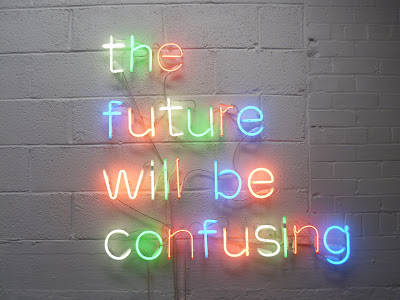 |
| Part of Gallery Installation at Neon Workshops by Tim Etchells http://www.timetchells.com/ |
Richard begins by explaining that the first commercial neon sign went up outside a barbers shop in Paris 99 years ago and that West Yorkshire has a rich heritage in the craft. Until relatively recently, there were five major manufacturers in the county but then the industry suffered a rapid decline. The demise was due to the introduction of L.E.D.s and popularity of moving plasma adverts. Somewhat seedy associations ('red light district' etc) and misconceptions about safety and cost did not help. By 2003 all the major neon companies in the county had closed down and last year the iconic Sanyo sign, the last neon sign in Piccadilly Circus, was decommissioned. There is still a niche market however and the Leeds area still has the highest concentration of neon manufacturers in the UK.
Summarising the process as 'exciting electrons in a tube' and a combination of science and art, he begins a demonstration by cutting a soda glass cane to size. The cane is heated, blown and twisted into shape, electrodes are attached then the gas is added using the wonderfully named 'electron blaster'. I can't remember what the 'live busbars' were for but they sounded very exciting too!
 |
| Richard expertly fusing electrodes onto tube |
 |
| Regulating the amount of gas added using the electron blaster. |
Although only three gases are inserted: neon (red), argon (blue) and helium, which acts as a cleaner, an amazing range of colours can be achieved with Richard's expert knowledge of colour theory. Colour can be altered by adjusting the ratio of gas, using tubes lined with differently coloured phosphur powder and using coloured and hand blown canes. The diameter of the cane affect the brightness, as can impurities. These are tested for and an 'ageing process' can be used where the impurities attach themselves to the electrodes to maximise the brightness.
He says that the perception that neon glass is unsafe and costly is exaggerated. Although most neon workshops have black floors and no natural light as it helps to see the flames, he prefers daylight and his workshop is full of windows. Glass is a poor conductor so you can hold it close to the flame and it will still be cold. He says it is rare to get burnt and you're more likely to get cut by handling the end of a cane without care. Although the cost of creating the item is undoubtedly high as it would take a craftsman with years of skill and experience hours to create, once made it is extremely long lasting and energy efficient. Only around 20mA of current is typically needed making running costs negligible. Other advantages are that the tubes never get hot and all parts are 100% recyclable.
Although it doesn't look easy, you really appreciate the skill involved by having a go. Once the glass is heated to the correct temperature, the timing is crucial. You only have about three seconds to shape it and you must blow at just the right time or the glass will crack as it cools. Richard has adapted his furniture to suit the way he works, such as the V-shapes cut into the tables and castors on the chairs that enable him to get the flames to the glass at just the right angle. All the furniture has castors to make the workspace as flexible as possible.
 |
| Me having a go. |
When I phoned Richard a few weeks ago and mentioned that I was studying textiles, he advised me to look up Dale Chihuly. For that I will be eternally grateful. I was completely blown away by the fantastic glass forms and vibrant colours, particularly the amazing sea forms series.
 |
| Cadmium Yellow Seaform Set with Red Lip Wraps 1990 © Dale Chihuly, used with permission of the artist |
Chihuly graduated with an Interior Design degree and while he was studying weaving, experimented with weaving glass strands into his work. From here he went on to try glass blowing and he is now one of the biggest names in the glass world. Following my visit to the Warriors of the Plains exhibition last month, I was also interested to see that Chihuly has been influenced by Native American textiles. The trade blankets and Navajo weaving that he loved and collected inspired his work. He was able to represent the folds of blankets in his glass forms and translate traditional Native American designs into his work, drawing with glass threads.
 |
| Peach Cylinder with Indian Blanket Drawing 1995 © Dale Chihuly, used with permission of the artist |
No comments:
Post a Comment